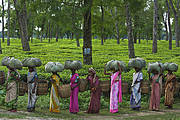Tea and biodiversity: a new approach to estate management
15 September 2012 | Article
Tea estates can play a major role in the conservation of biodiversity. In many countries around 20% of the land within tea estates is covered by natural or planted trees. This ecosystem provides important services such as carbon capture, crop pollination, pest control, and biodiversity, soil and water conservation. The Dilmah Bioregional Initiative (DBI) will help adopt a new integrated management approach for Dilmah tea estates.
Dilmah Conservation launched the DBI in partnership with IUCN and its World Commission on Protected Areas during the IUCN Congress. The initiative aims to support Dilmah in adopting a landscape approach to the management of those estates from which the company largely sources their tea.
“The DBI is centred on the emerging field of connectivity conservation. It seeks to link tea estates to the wider context of natural and productive lands with the aim of adopting a more integrated approach,” said Peter Shadie of IUCN’s World Commission on Protected Areas speaking at the launch. Improved connectivity is essential to conserve biodiversity and natural systems, he added.
The initiative supports global calls for better landscape integration by providing the added advantage of mobilising the private sector behind such approaches. It will be planned and implemented over several years and has the potential to become an umbrella programme demonstrating that connectivity works and can deliver multiple benefits to multiple stakeholders. The initiative highlights the value of integrating private land holdings into national biodiversity strategies to be used as a model to be replicated elsewhere.



